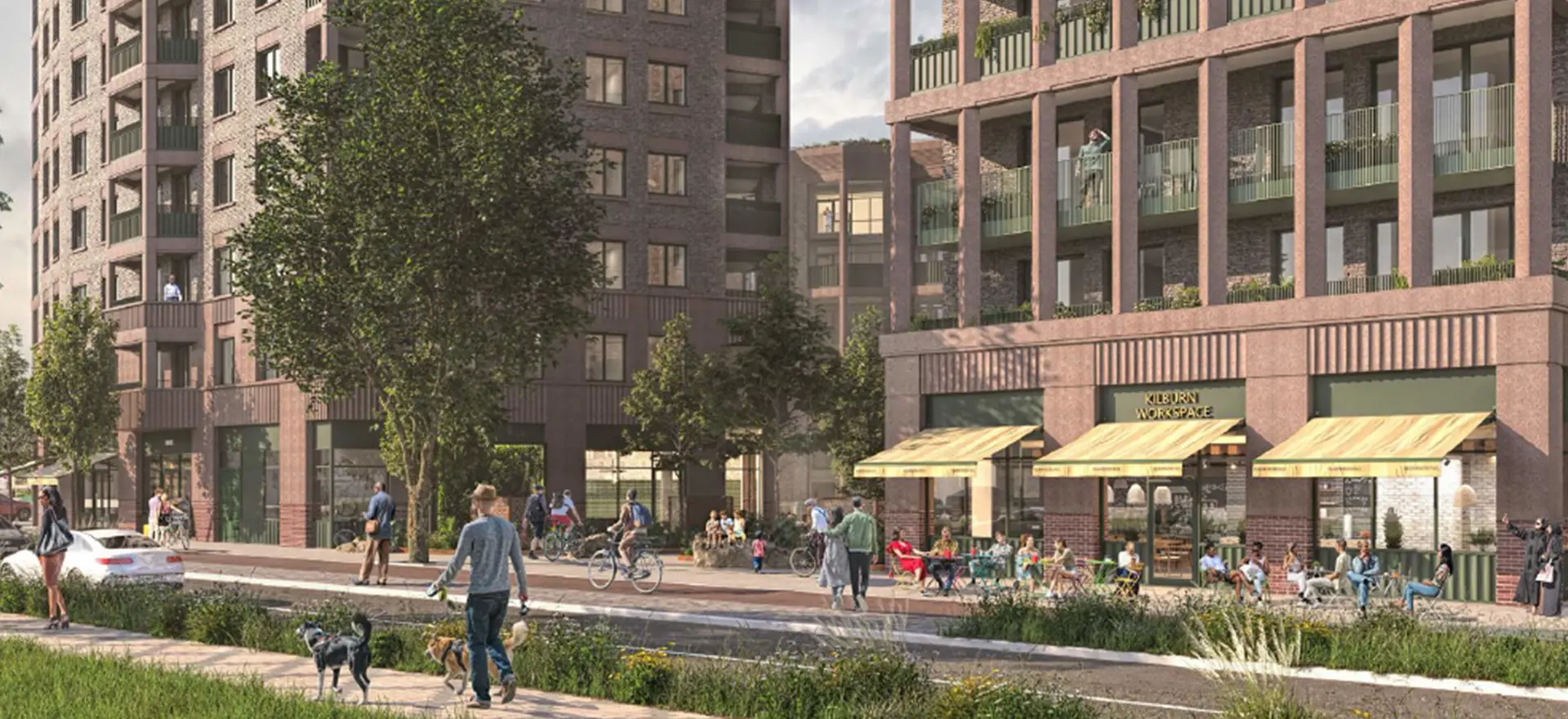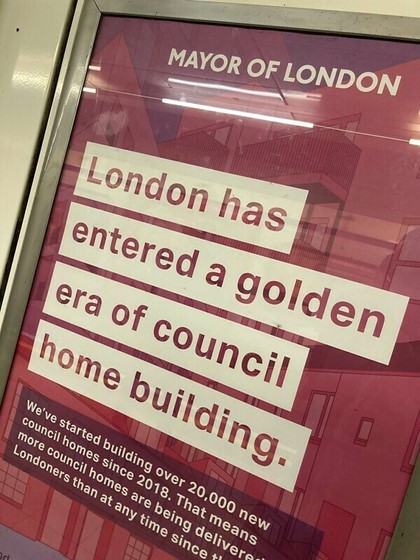On 8th May 2023, the Mayor of London used social media to herald progress on council house building:
“We’ve smashed our target to start building 20,000 council homes in London by 2024 - a whole year early. Whilst there’s no quick fix to London’s housing crisis, I’m proud of the progress we’re making to deliver a new golden era in council home building.”
[1]
The Mayor is surely correct that there is no quick fix. The GLA’s
Housing in London 2022[2]report sets out some of the latest stark figures on housing in the city:
-
Over 8,300 people were seen sleeping on London’s streets in 2021/22, of whom 5,000 were sleeping rough for the first time;
-
In 2019/20 the proportion of overcrowded households in London was 9.2% (an increase from 8.2% in 2018/19) and;
-
In 2020, 12% of all homes in London were below the official Decent Homes Standard.
Addressing these challenges is, rightly, a key priority for the Mayor of London and individual boroughs. The GLA has set out that it wants
‘every Londoner to have access to a good quality home that meets their needs and at a price they can afford’[3]. The Mayor’s Housing Strategy explains that: ‘
The Mayor believes the only way to solve London’s housing crisis over the long term is to build significantly more homes and for more of these to be genuinely affordable’.New council housing is therefore seen by many as part of the package of solutions to achieving this goal, but what progress is being made, and how close are we the promised ‘golden era’?
Who delivers new housing in London?
The chart below shows that as a proportion of all new housing starts in London, local authority direct delivery of housing is very low; in 2022-23, DLUHC’s monitoring data indicates that only 4% of all new housing starts were by local authorities (albeit this is higher than the national figure of 1%).
[4]
New housing starts in London, 2009/10 – 2022/23
The Mayor’s strategic target in the London Plan is for half of all new housing to be affordable
[5]. However, the latest London Plan AMR (AMR 17) indicates that delivery of affordable housing in 2019/2020 comprised just 20% of all new homes, an increase of 1% from the previous monitoring year.
Who is delivering this housing? Data from the government on how new affordable housing is funded indicates that in London in 2021/22, new build affordable housing was delivered as set out below.
Sources of new affordable housing in London, 2021/22[6]
The direct contribution of London boroughs to the delivery of new affordable housing in London is therefore relatively limited, at only a fifth of total affordable housing delivery (equivalent to c. 2,488 units in 2021/22). The current level of delivery by private RPs and via S106 agreements is far from sufficient to meet total affordable housing need. It is therefore logical that the Mayor has been focusing his efforts on supporting LPAs in delivering new affordable housing; to do so he is able to allocate funding from the Affordable Homes Programme to housing providers including LPAs.
While funding from the GLA under the Affordable Homes Programme (and right to buy receipts) can only be spent on new affordable housing; London’s boroughs (and their housing companies) are able to use other funding sources such as their own assets and loans to build new housing, including market housing. Statistics on the amount of market housing delivered by local authorities are not readily available but this is part of many London boroughs’ strategies; for example, a cross-subsidy model is common on estate regeneration schemes.
[7]
A ‘golden era’ of Council-led house building?
The Mayor’s office recently promoted the ‘golden era of council home building’ both online and across the tube network. The campaign refers to 20,000 new council homes having been started since 2018. In reality, this figure represents a relatively small proportion of housing need; the London Plan SHMA
[8] identifies a need for 30,972 new low cost rented homes in London each year until 2041, and an additional 11,869 new intermediate homes. The 20,000 is equivalent to just 4,000 a year, or around 125 per year averaged across each Borough, and therefore represents only 9% of total affordable housing need.
Image credit: Matt Brown, Londonist
Nonetheless, it is true that in the last decade there has been an increase in the number of local authorities who have ambitions to deliver affordable housing directly in their constituencies. Research by Dr Janice Morphet and Professor Ben Clifford at UCL has identified that in 2023 94% of local authorities are active in providing housing in some way, with all London boroughs contributing. This is an increase from 80% in a similar survey undertaken in 2021.
[9] At Lichfields, we are working with local authorities across London (and the UK) who are involved in direct delivery of housing in their borough.
Many London boroughs are both ambitious and innovative in seeking to deliver affordable housing. Westminster
[10] and Waltham Forest
[11] have recently commissioned expert reports to investigate how new affordable homes can be delivered most effectively in their respective boroughs. Many local authorities recognise that that taking a mixed or blended approach with a number of different delivery mechanisms can be effective; this can include direct delivery by councils, delivery through a wholly owned housing company, partnerships and joint ventures with developers, Registered Providers and landowners, and community led housing development schemes. This blended approach allows the most appropriate model of housing delivery to be used for each scheme. For example, a small infill scheme might be well-suited to delivery by a local housing company, whereas a larger estate regeneration scheme could benefit from a partnership approach. Partnerships and joint ventures allow both risk and expertise to be shared, and can provide assurance on delivery to the GLA which may assist with securing grant funding.
Challenges and Opportunities
The opportunities for councils becoming involved directly in the delivery of housing are significant; from the ability to align delivery with need on the council’s waiting list, to making efficient use of council-owned land and assets. However, there are also a number of key challenges which may explain why local authorities’ share of new housing delivery remains low overall:
-
Local authorities are not immune to the pressures that Registered Providers are facing regarding the need to maintain, retrofit and refurbish existing housing stock to meet requirements and ambitions in relation to fire safety and net zero targets. The expenditure associated with this can make investing in new housing challenging, particularly in the context of current viability challenges for development in London.
-
In a London context specifically (and considering the London Plan’s requirement to optimise site capacity through the design-led approach), development is likely to be in the form of higher-density apartment blocks which, compared to building out schemes comprising individual houses, are more capital intensive, can have a slower return on investment and for the market element carry sales risk. Delivering even 125 homes a year will require a funding envelope for the Council’s housing delivery of many millions of pounds. This, combined with the financial challenges faced by authorities such as Croydon
[12] and Birmingham
[13], may make London’s boroughs reluctant to take on development risk.
-
A number of local authorities have experienced difficulties with their wholly owned housing companies, and some such as Lambeth and Lewisham have decided to consolidate these back into the council. In Lambeth, this followed receipt of the recommendations of the Kerslake review
[14] which critiqued Homes for Lambeth, citing a lack of overarching purpose, slow progress in an estate renewal programme which had damaged relationships with residents, and complex and unclear governance. London’s boroughs therefore need to give careful thought to the most appropriate mechanism and organisational structure for delivering new housing. Estate regeneration schemes in particular have significant potential for housing delivery but can take a long period of time and high levels of investment to bring forward.
-
Many of London’s boroughs are progressing with development programmes on council-owned land; however, the levels of public land ownership vary between boroughs
[15] and not all public-owned land is available for development. In central London boroughs such as Westminster, there is relatively less land available in public ownership, and there are significant constraints on the land that is available, such as heritage constraints. The GLA is working with public landowners to release land for housing where possible across London; alongside council-owned sites, hospital and school sites owned by other public bodies may have development potential. For non-public land, there are challenges for a Council-led delivery company to engage in the land market (in competition with the private sector, potentially) to secure a pipeline of sites for delivery.
-
Finally, the politics of housing delivery can be challenging even when development is private sector-led; when it is driven by local government there are added complications, particularly for controversial schemes. The political appetite, bandwith, and resilience to take on the risks associated with council-led house building is a key determinant. So too are the Council’s objectives in pursuing house building; some Council-led companies have embraced development activity in order to secure a commercial return on development and land value receipt to help support public service delivery, e.g. on social care and education. How might this objective be balanced against the social benefits of affordable housing delivery on schemes where viability is compromised?
Concluding Thoughts
Overall, the contribution that London’s councils are making to meeting affordable housing need in London remains relatively modest at around a fifth of total affordable housing delivery, and the Mayor’s claim that we have entered a new ‘golden era’ of council house building might be said by some to be premature. However, many of London’s boroughs have demonstrated they have ambitions and are motivated to increase their housing delivery programmes.
While securing affordable housing through the planning system via S106 agreements will remain a priority for the Mayor and London’s boroughs, current delivery is insufficient to meet affordable housing targets, and it is logical that the Mayor is looking to local authorities to assist in making up the shortfall.
However the challenges associated with local authority direct delivery of housing in London are significant, and the GLA will need to focus its efforts on helping London’s boroughs overcome these if they are to make a significant contribution to meeting affordable housing need.
[1] https://twitter.com/SadiqKhan/status/1655485461249376256
[2] https://data.london.gov.uk/housing/housing-in-london/
[3] https://www.london.gov.uk/programmes-strategies/housing-and-land/homes-londoners-affordable-homes-programmes/homes-londoners-affordable-homes-programme-2021-2026
[4] https://www.gov.uk/government/statistical-data-sets/live-tables-on-house-building (Table 217)
[5] https://www.london.gov.uk/sites/default/files/the_london_plan_2021.pdf
[6] https://www.gov.uk/government/statistical-data-sets/live-tables-on-affordable-housing-supply (Table 1011)
[7] See Lichfields’ Insight ‘Great Estates – Planning For Estate Regeneration in London
[8] https://www.london.gov.uk/sites/default/files/london_shma_2017.pdf
[9] Morphet, J. & Clifford, B. (2023) Local Authority Direct Provision of Housing in England: Desk Survey Report June 2023.
[10] https://www.westminster.gov.uk/future-of-westminster
[11] https://www.walthamforest.gov.uk/housing/waltham-forest-affordable-housing-commission
[12] https://www.bbc.co.uk/news/uk-england-london-63714274
[13] https://www.bbc.co.uk/news/uk-england-birmingham-66730165
[14] https://www.lambeth.gov.uk/housing/kerslake-review-strategic-delivery-new-affordable-homes-lambeth[15] See the GLA’s public land registry: https://apps.london.gov.uk/public-land/




